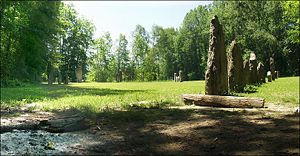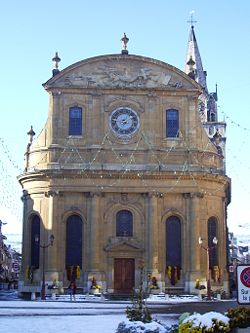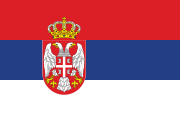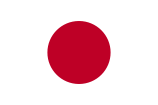Yverdon-les-Bains
| Yverdon-les-Bains | ||||||||||
|---|---|---|---|---|---|---|---|---|---|---|
|
||||||||||
| Population | 24,887 (January 2007[update]) | |||||||||
| - Density | 2,210 /km² (5,724 /sq.mi.) | |||||||||
| Area | 11.26 km² (4.3 sq mi) | |||||||||
| Elevation | 435 m (1,427 ft) | |||||||||
| Postal code | 1400 | |||||||||
| SFOS number | 5938 | |||||||||
| Mayor | Remy Jaquier (as of 2008) FDP/PRD | |||||||||
| Surrounded by | Belmont-sur-Yverdon, Cheseaux-Noréaz, Cuarny, Ependes, Grandson, Gressy, Montagny-près-Yverdon, Pomy, Treycovagnes | |||||||||
| Twin towns | Nogent-sur-Marne (France), Winterthur (Switzerland), Prokuplje (Serbia), Kagamino (Japan), Pontarlier (France), Collesano (Italy) | |||||||||
| Website | www.yverdon.ch Profile |
|||||||||
 Yverdon-les-Bains
|
||||||||||
Yverdon-les-Bains (called Eburodunum and Ebredunum during the Roman era) is a municipality in the district of Yverdon of the canton of Vaud in Switzerland. It is the seat of the district.
Yverdon is located in the heart of a natural setting formed by the Jura mountains, the plains of the Orbe, the hills of the Broye and the Lake Neuchâtel. It is the second most important town in the Canton of Vaud. It is famous for its thermal springs and is an important regional centre for commerce and tourism.
Contents |
History
The heights nearby Yverdon seem to have been settled at least since the Neolithic Age about 5000 B.C.E., as present archeologic evidence shows. The town was at that time only a small market place, at the crossroads of terrestrial and fluvial communication ways. People began to settle, at first in temporary huts at the water-front, for fishers and merchants, then in permanent dwellings.

The Celtic Helvetii are said to have been the first permanent settlers of Eburodunum (Celtic and Roman name of Yverdon), from about the 2nd century B.C.E..
About a century later, the Romans realized the commercial and strategic importance of this place: it controlled major routes such as Geneva-Avenches, connecting the Rhone and Rhine basins, as well as those of Rhone and Danube.
The imposing Castrum, or stronghold, called Castrum Ebredunense was the second largest in Switzerland and demonstrated the importance the Romans attached to Yverdon. The port served as naval base for the barges supplying the defensive positions along the Rhine, which marked the North-Eastern border of the Empire. Thus the Roman "Vicus" of Eburodunum developed into a prosperous urban centre. The sulphur springs were already used for a thermal spa, as attested by excavations. It is even possible that the Helvetii appreciated the beneficial effects of these waters. ([1])
The Castrum
About a century after the first invasions of the Alemanni, when the "Vicus" had been completely destroyed, the Romans built a large military stronghold (about 325 C.E.). It covered about 5 acres (20,000 m2) and was protected by gigantic ramparts and 15 masonry towers (Castrum). The Barbarians invaded Italy in the 5th century, and threatened to assault Rome. In a last desperate effort to save the city, all troops stationed North of the Alps were ordered back to Italy. The garrison and the Roman administration had to abandon the Yverdon camp. The inhabitants of Eburodunum, up to then assigned to live beyond the ramparts, immediately took possession of the Castrum, using it for their own safety. Like this, Eburodunum-Yverdon survived the hard times, until the 15th century. ([2]) The Castrum was noted in the Notitia Dignitatum (dated c. 420 C.E.).
The Savoy Era

With the lake receding, the ancient town confined to the Castrum had lost its strategic position: no more direct access to the port, or to the new trade routes alongshore.
When Peter II of Savoy gradually extended his rule over the Pays de Vaud (Land of Vaud), he managed to impose road tolls as well as port and fishing taxes. He founded the new town ("Ville Neuve") of Yverdon, defended by walls and a castle. Construction works were launched around 1259 and attracted many settlers. ([3])
The Castle
The imposing main walls and their four towers were erected within a few years. The design of the castle followed the geometric characteristics used for castles set in plains, and had been planned by the young mason and architect Jacques de Saint-Georges. Jacques also planned Caernarvon Castle and built the castle Saint-Georges d'Espéranches, near Lyon.
Yverdon's castle used to be the residence of the castellans of the Savoy dynasty, until 1536, followed by the bailiffs of Bern state. In 1798, the Département du Léman became the castle's owner. The Département had been set up by the shortlived "Helvetian Republic" (1798–1803), imposed by Napoleon I.
A few years later, Yverdon acquired the castle, to entrust it to Johann Heinrich Pestalozzi and his institute. After 1838, the castle housed a public school. New classrooms were created, especially on the second floor: dividing walls were erected, additional windows changed the severe look of the castle's façade. After 1950, these classrooms were gradually abandoned; the last classes left in 1974. The original medieval structure was then restored. The castle is today a multi-purpose cultural centre, housing a regional museum, a theatre, various conference rooms and the oldest public library of French-speaking Switzerland, founded already in 1763. The library is now part of the castle museum, existing since 1830. ([4])
The Bernese era (1536–1798)
The Savoy rulers granted bountiful franchise and liberties to the burghers of Yverdon. The township prospered during the two hundred years preceding the Burgundy wars.
The Bernese conquest followed. During the nearly three hundred years of Bernese occupation, economic life continued to thrive.
The 18th century proved to be one of Yverdon's most favorable periods, marked by cultural and economic highlights. Then a town of about 2.000 inhabitants, Yverdon radiated as a spa, and as a centre of thought (58 tomes of Yverdon Encyclopedia, published between 1770 and 1780), being in close contact with the great minds and movements of the time. ([5])

The Town Hall
Burnand, its architect, erected the Town Hall between 1768 and 1773, on the site of the former covered market. Inside the building, beautiful furniture and decorations are displayed, faience stoves, panels, wainscots and paintings. The vaults of the ancient granary are used year-round for art exhibitions. ([6])
The Temple
The Geneva architect Billon erected this Protestant church in 1757, on the site of Notre-Dame chapel of the 14th century. Its spire had been rebuilt in 1608, on the base of the original one, for which huge, sculpted blocks from the ruins of the Roman ‘’Castrum’’ had been used.
14 stalls, figuring apostles and prophets, originate from the ancient chapel, and are ascribed to Claude de Peney, who had worked at Fribourg and Hauterive. Peney died in 1499, and Bon Bottolier, cabinetmaker in Lausanne, was charged to craft the stalls (1501–1502). Potier, of French origin, built the organ in 1766. ([7])
The Thermal Springs
The springs were known and used at least since the Roman era, but most probably before, at the time of the Helvetii. It is supposed that the spring was a sacred place, with some sort of wooden structure. Middle Age documents prove the existence of a spa centre, as early as 1429, and mention several useful buildings.
By 1728, the authorities decided to have a new spa constructed. Its reputation grew rapidly. The 18th century saw major developments and brilliant success, for the town and the spa. Then followed a period of decline: the spa lost its drive and popularity, and degraded to a simple political meeting point, by 1800 already. Completely neglected, the buildings dilapidated.
Encouraged by the Spanish scientist A. Gimbernat, the local Council decided to reconstruct the spa centre and to renovate its hotel in 1897. The consequences of the First World War (1914–1918) were detrimental, the number of guests having significantly declined. Its reputation remained however intact, until the 30’s.
Another period of decay followed, and by 1960 the centre and its equipment were again so dilapidated that they had to be closed. The idea of balneology had also completely changed. The Municipality repurchased the spa, including the neighbouring Château d'Entremonts. Restoration failed twice, but the project of 1974 could finally be realized two years later. The spa reopened in 1977. Prospects for further thermal springs were successful in 1982, and a new outdoor pool could be added a year later. Today, the spa welcomes more than 1.200 visitors per day. ([8])
Champ-Pittet Manor-House
The 18th century Manor-House, near the road to Yvonand, has served as summer residence of Frédéric Haldimann, burgher of Yverdon and first Governor of Canada (1777–1786), when this territory became part of the British crown.
This country-seat belongs now to Pro Natura, the Swiss League for the Protection of Nature, organizing special exhibitions, audio-visual shows as well as guided tours of the nature reserve, the Grande Caricaie. ([9])
Famous buildings and locations
- the "Menhirs-Statues", including the stone rows at Clendy, dating as far back as the third millennium BC
- the Castrum, remains of gigantic ramparts and towers from the Roman era
- the thermal springs
- the thirteenth-century castle
- the "Temple", an eighteenth-century Protestant church
- the Grande Caricaie, a nature reserve stretching along the southern shore of Lake Neuchâtel
- the Maison d'Ailleurs (House of Elsewhere), "a museum of science fiction, utopia and extraordinary journeys", founded in 1976 and the only museum of its kind in Europe
- the Benno Besson Theatre, oldest theatre of Yverdon built in 1898.
- Town Hall Gallery
Famous residents
- Jean-Jacques Rousseau
- Fortuné-Barthélémy de Félice
- Viscount Yverdon
- Henri Pestalozzi
- Friedrich Fröbel
- Sir Frederick Haldimand
- Jona von Ustinov
Twin Cities
 Nogent-sur-Marne (France)
Nogent-sur-Marne (France) Winterthur (Switzerland)
Winterthur (Switzerland) Prokuplje (Serbia)
Prokuplje (Serbia) Kagamino (Japan)
Kagamino (Japan) Pontarlier (France)
Pontarlier (France) Collesano (Italy)
Collesano (Italy)
External links
- City of Yverdon, official site
- The official tourism homepage of Yverdon
- Yverdon-les-Bains travel guide from Wikitravel
- Maison d'Ailleurs website
- Swiss Fashion Museum
- Records and Research Centre Pestalozzi
- Benno Besson Theatre
- Echandole Theatre
- Town Hall Gallery
- Grande Caricaie reserve
- Champ-Pittet Nature Centre
- Spa - Thermal Centre
- China in 18th century Yverdon
References
- This article incorporates text from the public domain Dictionary of Greek and Roman Geography by William Smith (1856).
|
|||||||

